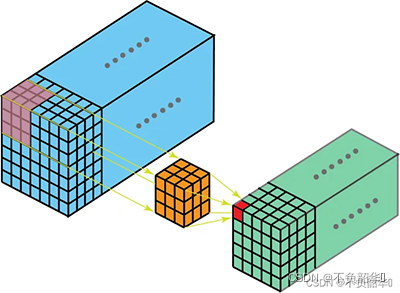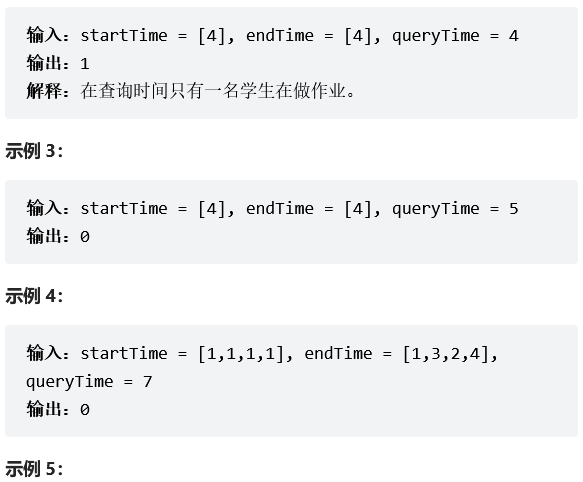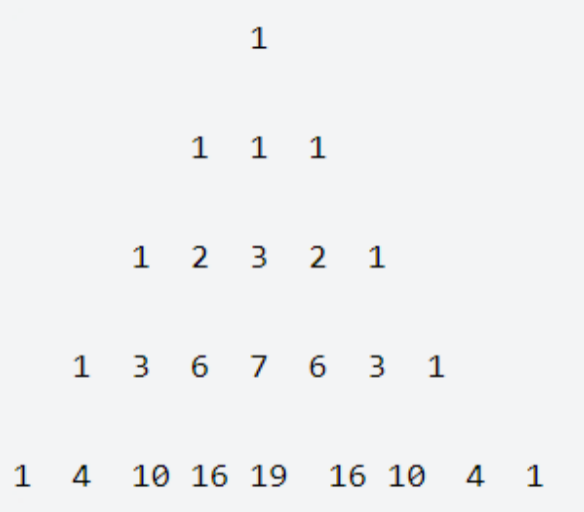当前位置:网站首页>tf. keras. layers. Conv? D function
tf. keras. layers. Conv? D function
2022-04-23 02:56:00 【Live up to your youth】
1、tf.keras.layers.Conv1D function
The function prototype
tf.keras.layers.Conv1D(filters,
kernel_size,
strides=1,
padding='valid',
data_format='channels_last',
dilation_rate=1,
groups=1,
activation=None,
use_bias=True,
kernel_initializer='glorot_uniform',
bias_initializer='zeros',
kernel_regularizer=None,
bias_regularizer=None,
activity_regularizer=None,
kernel_constraint=None,
bias_constraint=None,
**kwargs
)
Function description
One dimensional convolution layer is used for convolution in a single spatial or temporal dimension . Usually used for Sequence model 、 natural language processing field .

The convolution process is shown in the figure above , The size of the input vector is 20, The convolution kernel size is 5, step ( Each step moves a distance ) by 1, Filling... Is not considered , Then the size of the output vector is (20 - 5) / 1 + 1 = 16; If you consider filling , Then the size of the output vector is 20 / 1 = 20.
A more general , Suppose the input vector size is F, The convolution kernel size is K, In steps of S, The filling method is “VALID”( That is, filling is not considered ), So the size of the output vector N= (F - K / S) + 1; If the filling method is “SAME”( Step size... Not considered , Make the input matrix and output matrix the same size ), Then the output vector size N = F / S
Parameters filters Is the dimension of the output space , Generally, the last dimension of input data is changed . For one-dimensional convolution , The input data is usually three-dimensional , Shape is (batch_size, d_size, n_dim),batch_size Indicates the number of batch data ,d_size Represents the size of each data ,n_dim Represents the dimension of the data element .
Parameters kernel_size Represents the size of the convolution kernel ; Parameters strides Indicating step size , The default is 1;padding Indicates the filling method , The default is VALID, That is, no filling .
In addition, there are some commonly used parameters , such as activation Is the activation function ,use_bias Indicates whether an offset matrix is used , The default is True,kernel_initializer Represents the kernel matrix used ,bias_initializer Represents the offset matrix used .
There are also three parameters kernel_regularizer、bias_regularizer、activity_regularizer Respectively used to calculate the kernel matrix through the regularizer 、 Bias matrix 、 Of the output matrix of the activation function loss. After this layer is output ,tf.losses Medium loss The loss function will get the loss.
The regularizer is mainly used to prevent overfitting , There are two commonly used regularizers L1 and L2, They calculate the loss function differently .
L1 Calculate the loss loss The way loss = l1 * reduce_sum(abs(x)), among l1=0.01;L2 Calculate the loss loss The way loss = l2 * reduce_sum(square(x)), among l2=0.01.
If this layer is used as the first layer , You need to provide a parameter input_shape To specify the size of the input tensor .
The usage function
First example
model = tf.keras.Sequential([
# One dimensional convolution , The output shape is (None, 16, 8), Definition input_shape As the first floor
tf.keras.layers.Conv1D(8, 5, activation="relu", input_shape=(20, 1)),
# One dimensional maximum pool layer , The output shape is (None, 8, 8)
tf.keras.layers.MaxPooling1D(2),
# Flattening layer
tf.keras.layers.Flatten(),
# Fully connected layer
tf.keras.layers.Dense(4)
])
Model: "sequential"
_________________________________________________________________
Layer (type) Output Shape Param #
=================================================================
conv1d (Conv1D) (None, 16, 8) 48
max_pooling1d (MaxPooling1D (None, 8, 8) 0
)
flatten (Flatten) (None, 64) 0
dense (Dense) (None, 4) 260
=================================================================
Total params: 308
Trainable params: 308
Non-trainable params: 0
_________________________________________________________________
Second example
model = tf.keras.Sequential([
# Input layer , The output shape is (None, 20, 1)
tf.keras.layers.InputLayer(input_shape=(20, 1)),
# One dimensional convolution , The output shape is (None, 16, 8)
tf.keras.layers.Conv1D(8, 5, activation="relu"),
# One dimensional maximum pool layer , The output shape is (None, 8, 8)
tf.keras.layers.MaxPooling1D(2),
# One dimensional convolution
tf.keras.layers.Conv1D(16, 3, activation="relu"),
# One dimensional maximum pool layer
tf.keras.layers.MaxPooling1D(2),
# Flattening layer
tf.keras.layers.Flatten(),
# Fully connected layer
tf.keras.layers.Dense(4)
])
Model: "sequential"
_________________________________________________________________
Layer (type) Output Shape Param #
=================================================================
conv1d (Conv1D) (None, 16, 8) 48
max_pooling1d (MaxPooling1D (None, 8, 8) 0
)
conv1d_1 (Conv1D) (None, 6, 16) 400
max_pooling1d_1 (MaxPooling (None, 3, 16) 0
1D)
flatten (Flatten) (None, 48) 0
dense (Dense) (None, 4) 196
=================================================================
Total params: 644
Trainable params: 644
Non-trainable params: 0
_________________________________________________________________
2、tf.keras.layers.Conv2D function
The function prototype
tf.keras.layers.Conv2D(
filters,
kernel_size,
strides=(1, 1),
padding='valid',
data_format=None,
dilation_rate=(1, 1),
groups=1,
activation=None,
use_bias=True,
kernel_initializer='glorot_uniform',
bias_initializer='zeros',
kernel_regularizer=None,
bias_regularizer=None,
activity_regularizer=None,
kernel_constraint=None,
bias_constraint=None,
**kwargs
)
Function description
Two dimensional convolution layer is generally used in image processing 、 In the field of computer vision . Convolution on two dimensions .

The operation of two-dimensional convolution is similar to that of one bit convolution , It just adds a dimension . As shown in the figure above , The size of the input matrix is 5×5, The size of convolution kernel matrix is 3×3, stay x, y Move the direction in steps of (1, 1), The filling method is adopted (SAME) Convolution . The result is a matrix with the same size as the input matrix (5×5).
The calculation formula of two-dimensional convolution is similar to that of one-dimensional convolution , Suppose the size of the input image is F×F, The size of convolution kernel matrix is K×K, In steps of (S,S), If the filling method is VALID, The output image size is N×N, Then there are N = (F - K / S) + 1; If the filling method is SAME, Then there are N = F / S.
Parameters filters、kernel_size、strides、padding wait , The meaning of these parameters is the same as that of the corresponding parameters in one-dimensional convolution layer , The difference is that the form of parameters is different . For example Conv1D in kernel_size=5 Indicates that the size of the convolution kernel is 5, stay Conv2D in kernel_size It should be for (5, 5) Indicates that the size of the convolution kernel is 5×5.
Parameters dilation_rate Represents the expansion rate , For the expansion of kernel matrix . It can be a single integer , Specify the same value for all spatial dimensions .
The input data of two-dimensional convolution layer must be four-dimensional , Shape is (batch_size, height, width, channels),batch_size Indicates the size of batch data ,height Indicates the height of the data ,width Represents the width of the data ,channels Indicates the number of channels .
Function USES
model = tf.keras.Sequential([
# Input layer , Shape of the output (None, 128, 128, 3)
tf.keras.layers.InputLayer(input_shape=(128, 128, 3)),
# Two dimensional convolution , Shape of the output (None, 42, 42, 16)
tf.keras.layers.Conv2D(16, (5, 5), (3, 3), activation="relu"),
# Two dimensional maximum pool layer , Shape of the output (None, 21, 21, 16)
tf.keras.layers.MaxPooling2D((2, 2)),
# Two dimensional convolution , Shape of the output (None, 5, 5, 32)
tf.keras.layers.Conv2D(32, (5, 5), (4, 4), activation="relu"),
# Two dimensional maximum pool layer , Shape of the output (None, 1, 1, 32)
tf.keras.layers.MaxPooling2D((5, 5)),
# Flattening layer , Shape of the output (None, 32)
tf.keras.layers.Flatten(),
# Fully connected layer , Shape of the output (None, 4)
tf.keras.layers.Dense(4)
])
Model: "sequential"
_________________________________________________________________
Layer (type) Output Shape Param #
=================================================================
conv2d (Conv2D) (None, 42, 42, 16) 1216
max_pooling2d (MaxPooling2D (None, 21, 21, 16) 0
)
conv2d_1 (Conv2D) (None, 5, 5, 32) 12832
max_pooling2d_1 (MaxPooling (None, 1, 1, 32) 0
2D)
flatten (Flatten) (None, 32) 0
dense (Dense) (None, 4) 132
=================================================================
Total params: 14,180
Trainable params: 14,180
Non-trainable params: 0
_________________________________________________________________
3、tf.keras.layers.Conv3D function
The function prototype
tf.keras.layers.Conv3D(
filters,
kernel_size,
strides=(1, 1, 1),
padding='valid',
data_format=None,
dilation_rate=(1, 1, 1),
groups=1,
activation=None,
use_bias=True,
kernel_initializer='glorot_uniform',
bias_initializer='zeros',
kernel_regularizer=None,
bias_regularizer=None,
activity_regularizer=None,
kernel_constraint=None,
bias_constraint=None,
**kwargs
)
Function description
Three dimensional convolution is used in the field of medicine 、 In the field of video processing ( Detect character behavior ), For convolution of three dimensions .

Three dimensional convolution applies a three-dimensional filter to the data set , Filter direction 3 A direction (x,y,z) Move , Calculate the low-level feature representation . The output shape is a three-dimensional volume space , Such as a cube or box . Help video 、 Target detection of three-dimensional medical images .
The meaning of parameters and Conv1D and Conv2D similar , No more details here . The input shape of three-dimensional convolution is five-dimensional tensor (batch_size, frames, height, width, channels),batch_size Is the size of the batch data ,frams It can be understood as the number of frames in the video , Each frame is an image ,height Is the height of the image ,width Is the width of the image ,channels Is the number of image channels . The output shape is also a five-dimensional tensor .
Function USES
model = tf.keras.Sequential([
# Input layer , Shape of the output (None, 128, 128, 128, 3)
tf.keras.layers.InputLayer(input_shape=(128, 128, 128, 3)),
# Three dimensional convolution , Shape of the output (None, 42, 42, 42, 16)
tf.keras.layers.Conv3D(16, (5, 5, 5), (3, 3, 3), activation="relu"),
# Three dimensional maximum pool layer , Shape of the output (None, 21, 21, 21, 16)
tf.keras.layers.MaxPooling3D((2, 2, 2)),
# Three dimensional convolution , Shape of the output (None, 5, 5, 5, 32)
tf.keras.layers.Conv3D(32, (5, 5, 5), (4, 4, 4), activation="relu"),
# Three dimensional maximum pool layer , Shape of the output (None, 1, 1, 1, 32)
tf.keras.layers.MaxPooling3D((5, 5, 5)),
# Flattening layer , Shape of the output (None, 32)
tf.keras.layers.Flatten(),
# Fully connected layer , The output shape is (None, 16)
tf.keras.layers.Dense(16, activation="relu"),
# Fully connected layer , Shape of the output (None, 4)
tf.keras.layers.Dense(4, activation="tanh")
])
Model: "sequential"
_________________________________________________________________
Layer (type) Output Shape Param #
=================================================================
conv3d (Conv3D) (None, 42, 42, 42, 16) 6016
max_pooling3d (MaxPooling3D (None, 21, 21, 21, 16) 0
)
conv3d_1 (Conv3D) (None, 5, 5, 5, 32) 64032
max_pooling3d_1 (MaxPooling (None, 1, 1, 1, 32) 0
3D)
flatten (Flatten) (None, 32) 0
dense (Dense) (None, 16) 528
dense_1 (Dense) (None, 4) 68
=================================================================
Total params: 70,644
Trainable params: 70,644
Non-trainable params: 0
_________________________________________________________________
版权声明
本文为[Live up to your youth]所创,转载请带上原文链接,感谢
https://yzsam.com/2022/04/202204220657127335.html
边栏推荐
- [if you want to do a good job, you must first use its tools] Guide for downloading and using paper editing and document management (endnote, latex, jabref, overflow) resources
- Reverse a linked list < difficulty coefficient >
- JS learning notes
- Practical combat of industrial defect detection project (II) -- steel surface defect detection based on deep learning framework yolov5
- The problem of removing spaces from strings
- leangoo脑图-共享式多人协作思维导图工具分享
- Shell learning notes -- shell processing of output stream awk
- Shell script learning notes -- shell operation on files sed
- 重大危险源企业如何保障年底前完成双预防机制数字化建设任务
- 基于多态的职工管理系统源码与一些理解
猜你喜欢

C language 171 Number of recent palindromes

The interface request takes too long. Jstack observes the lock holding

LeetCode 1450 - 1453
![[wechat applet] set the bottom menu (tabbar) for the applet](/img/e2/98711dfb1350599cbdbdf13508b84f.png)
[wechat applet] set the bottom menu (tabbar) for the applet

Linux Redis——Redis 数据库缓存服务

ROP Emporium x86_64 7~8题

Huawei machine test question -- deformation of hj53 Yang Hui triangle

Cloud computing learning 1 - openstack cloud computing installation and deployment steps with pictures and texts (Xiandian 2.2)

ele之Table表格的封装

Traversal of l2-006 tree (middle and later order determination binary tree & sequence traversal)
随机推荐
Plug in for vscode
Actual combat of industrial defect detection project (IV) -- ceramic defect detection based on hrnet
Classification of technology selection (2022)
【Hcip】OSPF常用的6种LSA详解
BLDC double closed loop (speed PI + current PI) Simulink simulation model
《信息系统项目管理师总结》第七章 项目沟通管理
Practice of industrial defect detection project (III) -- Based on FPN_ PCB defect detection of tensorflow
First knowledge of C language ~ branch statements
Mosaic Routing: implement / home / news
JZ76 删除链表中重复的结点
《信息系统项目管理师总结》第五章 项目质量管理
MySQL复杂查询使用临时表/with as(类似表变量)
JS learning notes
C语言 171. 最近回文数
The usage of case when and select case when is very easy to use
学习正则表达式选项、断言
Modification du contenu de la recherche dans la boîte déroulante par PHP + MySQL
Chapter VI project information management system summary
Win view port occupation command line
Typescript Learning Guide